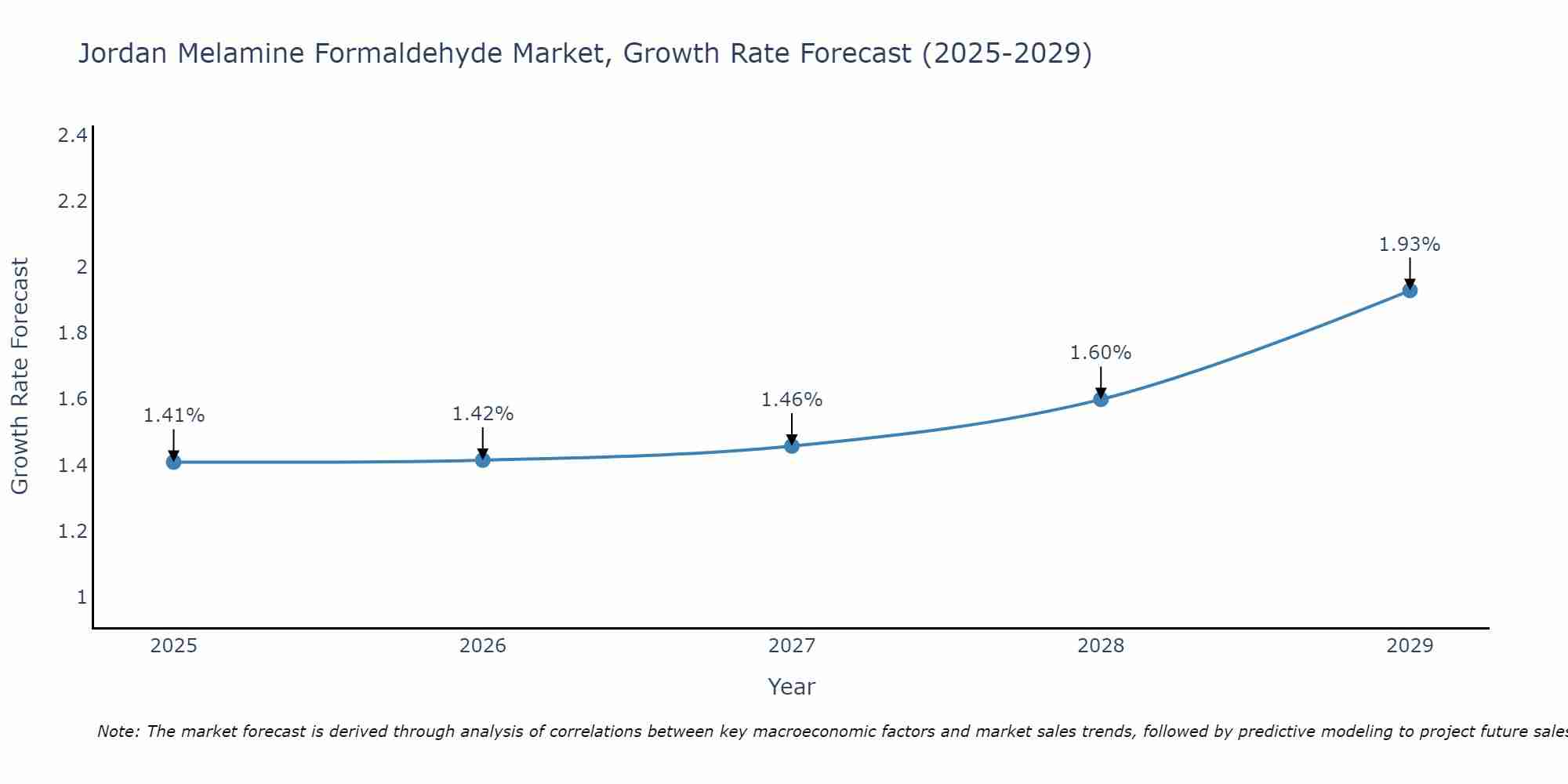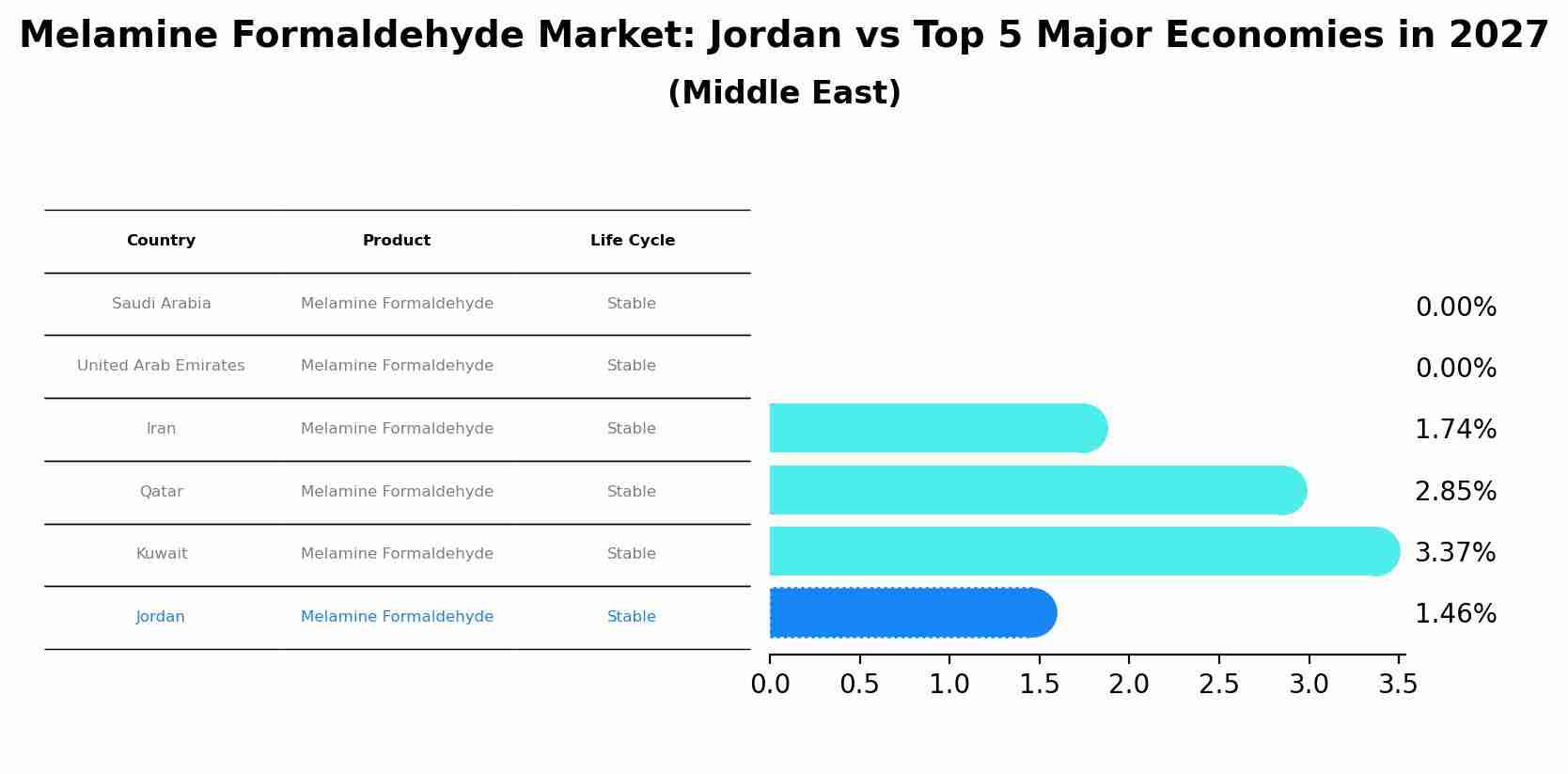Jordan Melamine Formaldehyde Market (2025-2031) Outlook | Growth, Value, Forecast, Revenue, Share, Trends, Analysis, Companies, Industry & Size
| Product Code: ETC110165 | Publication Date: Jun 2021 | Updated Date: Apr 2025 | Product Type: Report | |
| Publisher: 6Wresearch | Author: Ravi Bhandari | No. of Pages: 70 | No. of Figures: 35 | No. of Tables: 5 |
Jordan Melamine Formaldehyde Market Size Growth Rate
The Jordan Melamine Formaldehyde Market is poised for steady growth rate improvements from 2025 to 2029. The growth rate starts at 1.41% in 2025 and reaches 1.93% by 2029.

Melamine Formaldehyde Market: Jordan vs Top 5 Major Economies in 2027 (Middle East)
In the Middle East region, the Melamine Formaldehyde market in Jordan is projected to expand at a stable growth rate of 1.46% by 2027. The largest economy is Saudi Arabia, followed by United Arab Emirates, Iran, Qatar and Kuwait.

Jordan Melamine Formaldehyde Market Overview
The melamine formaldehyde market in Jordan is growing due to its application in manufacturing laminates, adhesives, and coatings. Melamine formaldehyde resins offer excellent durability, heat resistance, and aesthetic properties, making them ideal for use in the construction, automotive, and furniture industries. The market is influenced by the rising demand for high-performance and decorative materials.
Drivers of the market
The Jordan Melamine Formaldehyde Market is driven by its wide range of applications in laminates, adhesives, molding compounds, and coatings. The growth of the construction and furniture industries, which use melamine formaldehyde in decorative laminates and durable coatings, is a significant driver. Additionally, the demand for high-performance adhesives and resins in the automotive and electronics sectors is contributing to market growth. Advancements in melamine formaldehyde formulations, offering improved properties such as heat resistance and chemical stability, are also propelling demand. The emphasis on sustainable and low-emission materials is further driving the market.
Challenges of the market
The melamine formaldehyde market faces challenges such as the volatility of raw material prices and the need for environmentally friendly production processes. Additionally, addressing health and safety concerns related to formaldehyde emissions is critical.
Government Policy of the market
The Jordan government supports the melamine formaldehyde market through policies that promote industrial growth and environmental compliance. Financial incentives are provided for companies adopting sustainable production practices and investing in advanced manufacturing technologies. Regulations ensure that melamine formaldehyde products meet health and safety standards, protecting consumers and supporting market development.
Key Highlights of the Report:
- Jordan Melamine Formaldehyde Market Outlook
- Market Size of Jordan Melamine Formaldehyde Market, 2024
- Forecast of Jordan Melamine Formaldehyde Market, 2031
- Historical Data and Forecast of Jordan Melamine Formaldehyde Revenues & Volume for the Period 2021-2031
- Jordan Melamine Formaldehyde Market Trend Evolution
- Jordan Melamine Formaldehyde Market Drivers and Challenges
- Jordan Melamine Formaldehyde Price Trends
- Jordan Melamine Formaldehyde Porter's Five Forces
- Jordan Melamine Formaldehyde Industry Life Cycle
- Historical Data and Forecast of Jordan Melamine Formaldehyde Market Revenues & Volume By Type for the Period 2021-2031
- Historical Data and Forecast of Jordan Melamine Formaldehyde Market Revenues & Volume By Methylated Melamine Formaldehyde Resin for the Period 2021-2031
- Historical Data and Forecast of Jordan Melamine Formaldehyde Market Revenues & Volume By Non-methylated Melamine Formaldehyde Resin for the Period 2021-2031
- Historical Data and Forecast of Jordan Melamine Formaldehyde Market Revenues & Volume By Application for the Period 2021-2031
- Historical Data and Forecast of Jordan Melamine Formaldehyde Market Revenues & Volume By Laminates for the Period 2021-2031
- Historical Data and Forecast of Jordan Melamine Formaldehyde Market Revenues & Volume By Wood Adhesives for the Period 2021-2031
- Historical Data and Forecast of Jordan Melamine Formaldehyde Market Revenues & Volume By Molding Compounds for the Period 2021-2031
- Historical Data and Forecast of Jordan Melamine Formaldehyde Market Revenues & Volume By Paints and Coatings for the Period 2021-2031
- Historical Data and Forecast of Jordan Melamine Formaldehyde Market Revenues & Volume By Other Applications for the Period 2021-2031
- Jordan Melamine Formaldehyde Import Export Trade Statistics
- Market Opportunity Assessment By Type
- Market Opportunity Assessment By Application
- Jordan Melamine Formaldehyde Top Companies Market Share
- Jordan Melamine Formaldehyde Competitive Benchmarking By Technical and Operational Parameters
- Jordan Melamine Formaldehyde Company Profiles
- Jordan Melamine Formaldehyde Key Strategic Recommendations
Frequently Asked Questions About the Market Study (FAQs):
- Single User License$ 1,995
- Department License$ 2,400
- Site License$ 3,120
- Global License$ 3,795
Search
Related Reports
- ASEAN and Thailand Brain Health Supplements Market (2025-2031) | Strategy, Consumer Insights, Analysis, Investment Trends, Opportunities, Growth, Size, Share, Industry, Revenue, Segments, Value, Segmentation, Supply, Forecast, Restraints, Outlook, Competition, Drivers, Trends, Demand, Pricing Analysis, Competitive, Strategic Insights, Companies, Challenges
- ASEAN Bearings Market (2025-2031) | Strategy, Consumer Insights, Analysis, Investment Trends, Opportunities, Growth, Size, Share, Industry, Revenue, Segments, Value, Segmentation, Supply, Forecast, Restraints, Outlook, Competition, Drivers, Trends, Demand, Pricing Analysis, Competitive, Strategic Insights, Companies, Challenges
- Europe Flooring Market (2025-2031) | Outlook, Share, Industry, Trends, Forecast, Companies, Revenue, Size, Analysis, Growth & Value
- Saudi Arabia Manlift Market (2025-2031) | Outlook, Size, Growth, Trends, Companies, Industry, Revenue, Value, Share, Forecast & Analysis
- Uganda Excavator, Crane, and Wheel Loaders Market (2025-2031) | Strategy, Consumer Insights, Analysis, Investment Trends, Opportunities, Growth, Size, Share, Industry, Revenue, Segments, Value, Segmentation, Supply, Forecast, Restraints, Outlook, Competition, Drivers, Trends, Demand, Pricing Analysis, Competitive, Strategic Insights, Companies, Challenges
- Rwanda Excavator, Crane, and Wheel Loaders Market (2025-2031) | Strategy, Consumer Insights, Analysis, Investment Trends, Opportunities, Growth, Size, Share, Industry, Revenue, Segments, Value, Segmentation, Supply, Forecast, Restraints, Outlook, Competition, Drivers, Trends, Demand, Pricing Analysis, Competitive, Strategic Insights, Companies, Challenges
- Kenya Excavator, Crane, and Wheel Loaders Market (2025-2031) | Strategy, Consumer Insights, Analysis, Investment Trends, Opportunities, Growth, Size, Share, Industry, Revenue, Segments, Value, Segmentation, Supply, Forecast, Restraints, Outlook, Competition, Drivers, Trends, Demand, Pricing Analysis, Competitive, Strategic Insights, Companies, Challenges
- Angola Excavator, Crane, and Wheel Loaders Market (2025-2031) | Strategy, Consumer Insights, Analysis, Investment Trends, Opportunities, Growth, Size, Share, Industry, Revenue, Segments, Value, Segmentation, Supply, Forecast, Restraints, Outlook, Competition, Drivers, Trends, Demand, Pricing Analysis, Competitive, Strategic Insights, Companies, Challenges
- Israel Intelligent Transport System Market (2025-2031) | Strategy, Consumer Insights, Analysis, Investment Trends, Opportunities, Growth, Size, Share, Industry, Revenue, Segments, Value, Segmentation, Supply, Forecast, Restraints, Outlook, Competition, Drivers, Trends, Demand, Pricing Analysis, Competitive, Strategic Insights, Companies, Challenges
- Uganda Precast and Aggregate Market (2025-2031) | Strategy, Consumer Insights, Analysis, Investment Trends, Opportunities, Growth, Size, Share, Industry, Revenue, Segments, Value, Segmentation, Supply, Forecast, Restraints, Outlook, Competition, Drivers, Trends, Demand, Pricing Analysis, Competitive, Strategic Insights, Companies, Challenges
Industry Events and Analyst Meet
Our Clients
Whitepaper
- Middle East & Africa Commercial Security Market Click here to view more.
- Middle East & Africa Fire Safety Systems & Equipment Market Click here to view more.
- GCC Drone Market Click here to view more.
- Middle East Lighting Fixture Market Click here to view more.
- GCC Physical & Perimeter Security Market Click here to view more.
6WResearch In News
- Doha a strategic location for EV manufacturing hub: IPA Qatar
- Demand for luxury TVs surging in the GCC, says Samsung
- Empowering Growth: The Thriving Journey of Bangladesh’s Cable Industry
- Demand for luxury TVs surging in the GCC, says Samsung
- Video call with a traditional healer? Once unthinkable, it’s now common in South Africa
- Intelligent Buildings To Smooth GCC’s Path To Net Zero













